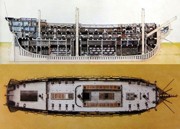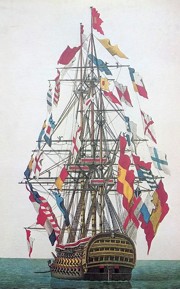Related content

HMS Victory

Anatomy of the ship of the line

Spanish ships of the line

Evolution of the ship of the line

The Sovereign of the Seas

The Wasa
|
The purpose of this article is to celebrate which was perhaps the noblest aspect of sailing warships: their artistic quality of their decoration.
This however does not mean that such ornamentation were art for art's sake. We probably could find diverse motivations but a prominent
incentive was royal arrogance. A mystical spirit can be attributed as well to these creations, sometimes filled with a whole repertoire of
religious and mythical figures, from which the ships could attain a more favorable fate. Besides, the transom of a sailing warship can be
considered as an accurate expression of the contemporary artistical mindset.
The age of wild baroquism
In 1610 the English presented to the world the first chief exponent of a "baroque warship", the Prince Royal. The idea of an extraordinarily
decorated warship was not new, attending to a model of a Flemish gallion from 1593 preserved in the Naval Museum of Madrid, but its execution was taken
further. Whereas the Flemish gallion had been covered with abstract motifs and multiplicity of colors, the Prince Royal featured
figurative sculptures painted mainly in a two-color scheme: green for the background and gilding for the figures, with a number of details painted in
white, particularly the three feathers representative of the Prince of Wales. The cost of gilding a warship was not a joke: the gilding and
painting of the Prince Royal (868 pounds, 6 shillings and 8 pennies) costed almost twice than the very sculptures (441 pounds and 4 pennies).
This fashion may seem strange for the modern mentality, but this was the way of reacting against the obscurantism of former centuries.

In 1625, Gustav II Adolph, King of Sweden, ordered to build the ill-fated Wasa, when large regions of Europe were devastated by the Thirty
Years War. Fortune was elusive in the battlefield and it was felt the need of a powerful war fleet. Armed with 64 cannons, the Wasa should be
somewhat superior to the Prince Royal, which was fitted with 56 cannons in that time. The Wasa was not particularly decorated on her sides but
on her prow and sterncastle glistened under the sun a myriad of polychome and gilded sculptures. And to further increase notoriety, the
sterncastle was made so tall that the emblem of the ship overlooked at 12 meters above the waterline.
It has been said that the decoration had been coated with gold sheets... but to which extent? In other representations, particularly the
"official" one from the Wasa Museum, the decoration is predominantly polychrome, which makes sense in a Nordic warship. From the multiple
colors would stand out the red used for the background. The colors in the figures would include red, flesh, yellow, green, blue, white and
black, with a certain amount of gilded parts. The representation below is very simplified due to reasons of clarity. The figures rescued from
the shipwreck included dragon and lion heads, fantastic cratures of the sea and figures of mythology and legend: caryatids in the shape of
mermaids, warriors wearing Roman armor, the head of a Roman emperor, griffins holding the royal crown, the coat of arms of the Wasa
dynasty (a scutcheon with a sheaf, carried by two cherubs) and the impressive lion of almost two tonnes which served as figurehead.

In 1634, Charles I of England ordered to the prestigious naval architect Phineas Pett - who on the other hand was the responsible of the
HMS Prince Royal - to build the largest warship in the world. But she would be as well the most richly decorated warship, not only in the
world, but in History. From the beakhead to the sterncastle passing by the side bulwarks, the ornamentation left no blank space, as we can
see in the excellent depictions below. In the time in which a 40-gun warship costed about 6000 sterling pounds, the Sovereign of the Seas costed
a total of 65586 pounds, 16 shillings and 9.5 pennies, and the gilding alone took roughly a tenth part of that amount.
The ornamentation has been attributed to the royal sculptor Gerard Christmas, his sons and assistants, following designs by Dutch painter
Anthony van Dyck. In many combats and minor encounters, the Dutch praised the English flagship and called her the "Golden Devil". The gilded
ornaments, highlighted against a black background, probably shone much more than what any painting can show.

The figurehead depicted Edgar the Peaceful overunning seven enemy kings with his horse. The bulwarks of the beakhead were decorated with the
whippets of Henry VII and the dragon of Cadwallader, the lion and the unicorn, the roses of England, the thistle of Scotland, the fleur-de-lis
of France and the harp of Ireland, with the royal acronyms and various heraldic animals. The cutwater was ornamented as well and there the
tacks of the fore sail passed through curly serpents. The stem was topped by a Cupid riding a lion and two satyrs smiled beneath the catheads.
The front face of the forecastle was decorated with six beautiful deities symbolizing Prudence, Caution, Diligence, Strength, Valor and Victory.
The bulwarks in the sides of the hull were decorated with three friezes: the lower one, relatively simple, had only escutcheons and volutes;
the middle one, interrupted by the gunports of the upper gun deck, had musical instruments, helmets, breastplates and various weapons; and the
upper one, running along the sides of the forecastle and the quarterdeck, displayed the signs of the Zodiac alternating with Roman emperors.
All throughout the ship the diverse motifs were separated by simple volutes or elaborated caryatids.
The stern galleries, enlivened with demi-cupolas and glass panels, were covered by mythological figures and scenes, escutcheons and royal
acronyms. The high stern was dominated by the Victory surrounded by Neptune, Jupiter, Jason and Hercules, and crowned by a huge hexagonal
lantern guarded by a lion and a unicorn. At the sides of the rudder, topped by a lion head, there was this inscription: "Qui mare, qui fluctus,
ventos, navesque gubernat, Sospitec hanc arcem, Carole magne, tuam", whose meaning has been interpreted as: "He to Whom the sea, the tides,
the winds and the ships obey, protect this one, oh great Charles, your ship, with divine substance."

The English and Dutch styles
In England, around 1660, it was customary to make models of the largest vessels which were designed, submitting them to the King and the
Admiralty for their approval before being built. One of the oldest models of the Admiralty, preserved in the South Kensington Science Museum,
is that of the 100-gun ship of the line Prince, from 1670. The model presents a richly decorated beakhead and also the catheads and the
uppermost gunports are decorated. Almost all of the ornamention is gilded over black background, like in the Sovereign of the Seas, but to
the gilded parts of the model corresponded yellow paint in the actual ship, and only the royal arms, always present in the transom of
English warships, were actually gilded.

The lyre-shaped transom was characteristic of Dutch warships in the same period on which the Prince was built. Such shape looks quite graceful
and the ornamentation was rather polychromatic, stylistically closer to the Nordic style. Green color was often used for the
backgroud and unlike in the English warships, the figures were painted in their natural colors rather than fully gilded. A typical figure were
the red lions, present not only in the transom but used as well as figurehead. The sides of the ship, painted in green as well, were almost
integrally deprived of ornamentation. But this is not unusual considering that these were medium-sized warships.

|